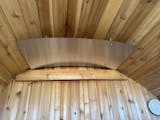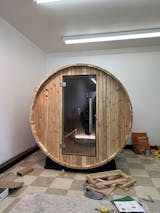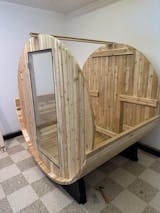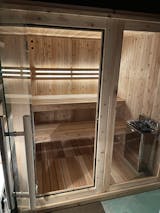Tried everything to circulate the hot air down. I saw this product and decided “why not”. Definitely works. Believe it or not, the sauna heats up faster and maintains the heat. Very happy with the heat shield
Thank you for your positive feedback regarding our Barrel Sauna Heat Shield. We are glad to hear that it has been effective in circulating the hot air and improving the heating process. We appreciate your support and are happy to know that you are satisfied with your purchase. Thank you for choosing our product.
We ordered the 4 person barrel sauna and love it! We wanted a little extra space for the 2 of us/guests and it’s great. We could definitely fit 4 people in it if we needed. We use it every single day. It took about 10 weeks to get here because they build it specifically for the order. Putting the barrel together was fairly easy with 2 people. The electrical and the heater definitely required an electrician to install as we could have not done it alone.
We ordered the biggest heater (harvia spirit 8kw) and it heats up the sauna in about 15 mins inside our 40-50° garage. Overall this style of sauna is hotter and you sweat a lot faster than in an infrared sauna. I truly 10/10 recommend!
Pic is of us in the middle of building it.
Thank you for taking the time to share your experience with our Almost Heaven Watoga 4-Person Standard Barrel Sauna! We are thrilled to hear that you are enjoying your sauna and that it has become a daily part of your routine. We apologize for the longer wait time, but we are glad to hear that the barrel was easy to assemble with two people. We are happy to hear that the heater is working efficiently and providing a hot and sweat-inducing experience. Thank you for the 10/10 recommendation and we hope you continue to enjoy your sauna for years to come!
Best prices around. Quality product and good instructions. Heats up to 180F in no time!
Hi Garett! Thank you for your kind words and for taking the time to leave a review! We're so glad to hear that you're enjoying your Almost Heaven Salem 2-person Standard Barrel Sauna. We strive to offer the best prices and high-quality products to our customers. It's great to hear that our instructions were helpful and that the sauna heats up quickly. We appreciate your business and hope you continue to enjoy your sauna!
The costumer service I received from My Sauna World was fantastic. We had a issue with a part of the sauna which was resolved quickly! My sauna was delivered in the expected time window and the sauna assembly instructions and process were fairly simple. We had a few accessories that we were unsure what to do with (some additional instruction would have been appreciated for those). There were contradictory instructions for the heater thermometer which left us guessing a bit as well. We opted to only install the upper bench to allow for some additional standing room and light yoga. Overall I highly recommend My Sauna World. We are loving our sauna!
Hi Katie! Thank you for your kind words and for choosing Almost Heaven Madison Sauna from My Sauna World. We are delighted to hear that our customer service has met your expectations and that any issues you had were resolved promptly. We apologize for any confusion with the accessories and instructions and will take your feedback into consideration for future improvements. We hope you continue to enjoy your sauna and thank you for recommending us.
I have wanted to get a sauna for years. The communication about the delivery was very clear. The packaging was simple to disassemble. The set up of the sauna was pretty intuitive. We have used the sauna every day since its completion. It really is incredibly awesome.
Thank you for your review, Michael! We are so glad to hear that you are enjoying your Almost Heaven Grayson sauna. We're happy to hear as well that everything went well from delivery to assembly of your sauna. We strive to have clear communication to guide our customers. We hope you continue to enjoy the sauna for years to come. Thank you for choosing us!












